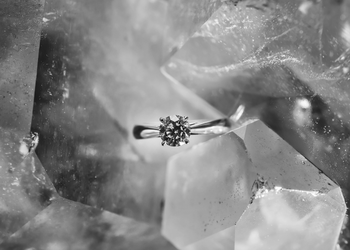
LABORATORY DIAMONDS OR DIAMONDS CREATED AN EMERGING INNOVATION THAT IS ALREADY CONSOLIDATED IN MARKETS SUCH AS THE AMERICAN OR ENGLISH ONE.
The jewelry market already experienced the arrival of synthetic rubies and sapphires at the beginning of the 20th century and synthetic emeralds in the 1930s.
The appearance of these materials, obtained in the laboratory, did not take away the magic of either the natural gems or those created in the laboratory.
Synthetic stones entered to satisfy a demand for high jewelry products, more accessible, sustainable and varied for consumers and professionals in the sector.
The latest innovation in this field occurred with the arrival of laboratory or created diamonds, also called sustainable diamonds, these are the diamonds used by ethical jewelry stores such as Mimoke, a pioneer in Southern Europe. Created diamonds take shape through science, ingenuity and human creativity, they have not been created in mines and since they are not created in mines, with dubious working conditions and with high environmental impact, created diamonds are the raw material par excellence of new ethical jewelry.
LAB CREATED DIAMOND, AN ALTERNATIVE CREATED BY AND FOR PEOPLE FOR SUSTAINABILITY, DESIGNED FOR THE CURRENT MOMENT WHERE MEASURES TO ADDRESS CLIMATE CHANGE ARE URGED.

WHAT IS THE COMPOSITION OF A LAB CREATED DIAMOND
Lab-grown diamonds are chemically, optically, and physically identical to those that form naturally. Only differentiated by being a diamond completely free of conflict typical of diamond and precious stone extraction mines and with a more affordable price, up to 50% lower than other diamonds.
Essentially, laboratory diamonds are made up of carbon molecules that align in a certain way, forming a diamond.
In nature, diamonds are formed in the Earth's mantle, with carbon molecules subjected to great pressure and high temperature that build the diamond over millions of years.
DIAMOND SYNTHESIS METHODS
In laboratory diamonds, crystal growth is completely natural, but occurs in an environment controlled by scientists and machines that replicate the same scenario that is created in nature.
The carbon molecules are subjected to high pressure and high heat for a short period of time depending on the intended size allowing them to form and align in the appropriate molecular manner.
There are two methods to do this:
- HPHT (HIGH PRESSURE AND HIGH TEMPERATURE) – HIGH PRESSURE AND HIGH TEMPERATURE METHOD
The HPHT method recreates the natural growth environment of a diamond found in the Earth's mantle. The machines used use a high degree of pressure and temperature, carrying out the crystallization process that can last millions of years in a couple of weeks.
Inside the machine, the growth cell contains all the elements necessary to grow a diamond, including a pure carbon seed - a catalytic mixture consisting of powders and metals and highly refined graphite. The seed is placed in the center of the HPHTP chamber where more than 50,000 atmospheres of pressure and constant temperatures reaching 13000 degrees Celsius are applied. The catalytic mixture is the first to react to the added pressure and heat and changes from solid to liquid (molten) form.
This molten solution causes the graphite inside the cell to dissolve. Once all the required conditions are met, the cooling process begins. This process takes days, allowing carbon atoms to grow on the seed. Once this process is completed, the growth cell is removed. The rough diamond is extracted and prepared for cutting and polishing.

- CVD (CHEMICAL VAPOR DEPOSITION) – CHEMICAL VAPOR DEPOSITION METHOD.
The CVD method, a small, thin slice of type IIA carbon seed is placed in a sealed chamber and heated to around 800 degrees. The chamber is filled with methane and other gases, these are ionized in plasma thanks to the high temperatures, breaking the molecular bonds of the gases. These adhere to the diamond seed and build up little by little creating a rough diamond.
ALTHOUGH IN AN ACCELERATED WAY AND CONTROLLED BY TECHNOLOGY, THE CRYSTALLIZATION OF CARBON MOLECULES OCCURS IN A COMPLETELY NATURAL, COMPLETELY ORGANIC WAY AND WITHOUT ANY HUMAN INTERVENTION.
This makes visible and justifies the value of Laboratory Diamonds at a more accessible price for a public that demands ethical products made through good practices throughout the value chain.
Science today already allows us to recreate diamonds identical to natural ones, improving in many cases the intrinsic quality of the gem at a much more permissive cost for everyone, professionals and consumers.
* * *
If you have questions about the processes of how Laboratory Diamonds are made, do not hesitate to contact us and we will inform you.



